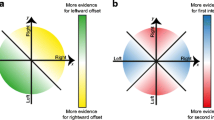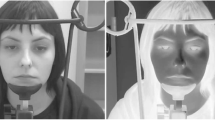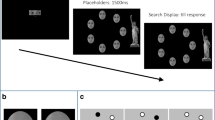Abstract
Following signal detection theory, the gazing of a videotaped confederate was judged by 12 subjects under four combinations of distance from the monitor and picture brightness. Separate measures of discriminability and judgment criterion, or bias, were derived. Eye gaze discriminability declined with both distance and brightness. Overestimation of the amount of eye gaze increased with distance and declining brightness, supporting Stephenson and Rutter's hypothesis that increased difficulty in discrimination will produce such a guessing bias.
Similar content being viewed by others
Reference Notes
Jones, R.F. & Martin, W.W. A signal detection approach to gaze accuracy judgment. Paper presented at Capital Area Social Psychology Association meetings Feb., 1977.
References
Anstis, S. M., Mayhew, J. W., & Morley, T. The perception of where a face or television ‘portrait’ is looking.American Journal of Psychology 1969,82 474–489.
Banks, W. P. Signal detection theory and human memory.Psychological Bulletin 1970,74 81–99.
Cline, M. G. The perception of where a person is looking.American Journal of Psychology 1967,80 41–50.
Gibson, J. J., & Pick, A. D. Perception of another person's looking behavior.American Journal of Psychology 1963,76 386–394.
Grier, J. B. Nonparametric indices for sensitivity and bias: Computing formulas.Psychological Bulletin 1971,75 424–429.
Knight, D. J., Langmeyer, D. L., & Lundgren, D. C. Eye-contact, distance and affiliation: The role of observer bias.Sociometry 1973,36 390–401.
Lord, C., & Haith, M. M. The perception of eye contact.Perception and Psychophysics 1974,16 (3), 413–416.
Martin, W. W. & Rovira, M. L. Signal detection theory: Its implications for social psychology.Personality and Social Psychology Bulletin. (in press) 1981.
Massaro, D. W.Experimental psychology and information processing. Chicago: Rand McNally, 1975.
Patterson, M. L. Eye-contact and distance: A re-examination of measurement problems.Personality and Social Psychology Bulletin 1975,1 600–603.
Scherwitz, L. & Helmreich, R. The interactive effect of eye-contact and verbal content on interpersonal attraction in dyads.Journal of Personality and Social Psychology 1973,25 6–14.
Stephenson, G. M., & Rutter, D. R. Eye-contact, distance and affiliation: A re-evaluation.British Journal of Psychology 1970,61 385–393.
Vine, I. Judgment of direction of gaze: An interpretation of discrepant results.British Journal of Social and Clinical Psychology 1971,10 320–331.
von Cranach, M. The role of orienting behavior in human interaction. In A. H. Esser (Ed.),Environment and Behavior, The Use of Space by Animals and Man New York: Plenum, 1971.
von Cranach, M., & Ellgring, J. H. Problems in the recognition of gaze direction. In M. von Cranach and I. Vine (Eds.),Social communication and movement. London: Academic Press, 1973.
White, J. H., Hegarty, J. R. & Beasley, N. A. Eye contact and observer bias: A research note.British Journal of Psychology 1970,61 271–273.
Author information
Authors and Affiliations
Additional information
Thanks to Maureen Mc Carry for serving as the gazer. This project was partially supported by the Boystown Center for the Study of Youth Development at Catholic University.
Rights and permissions
About this article
Cite this article
Martin, W.W., Rovira, M.L. An experimental analysis of discriminability and bias in eye-gaze judgment. J Nonverbal Behav 5, 155–163 (1981). https://doi.org/10.1007/BF00986132
Issue Date:
DOI: https://doi.org/10.1007/BF00986132




